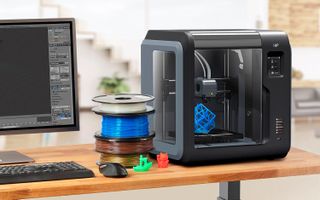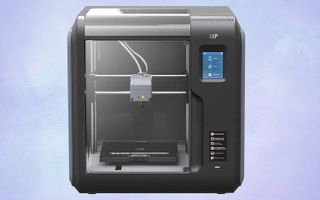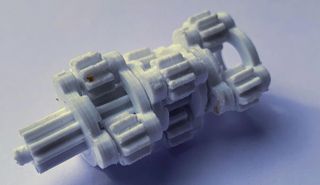Monoprice Voxel 3D printer review: The best value for 3D printing beginners
There's a lot to like with the Monoprice Voxel, a neat 3D printer that produces high-quality prints
Why you can trust Tom's Guide

The Monoprice Voxel is a neat, low-priced 3D printer that offers a lot for the home user. For a relatively low price, you get a 3D printer that can handle PLA and ABS filament with equally high print quality while also offering a decent-size fully enclosed build space.
The MP Voxel has are some rough edges, however: Buggy firmware and so-so software make printing a bit more difficult than it should be. Even so, the MP Voxel is an attractively priced package for school or home use, and it produces high-quality prints, and we think it's among the best 3D printers you can buy, especially for budget models.
Monoprice Voxel review: Price and availability
These days, you'll find the Monoprice Voxel available at Monoprice's website for $449. But some online retailers, including Amazon, offer the 3D printer at a discount, with the price often falling below $400.
That's not the cheapest price we've seen on a printer — you can get the XYZprinting da Vinci Nano for about $250 less. But it's a pretty good value for a printer aimed at novices.
Monoprice Voxel review: Design
The MP Voxel has a simple, dark design, with an enclosed frame of black plastic. Clear panels that you can lift off cover the front and top of the enclosure, providing access to the print area and the mechanism. The print volume is 6.9 inches on each side, for a total of about 329 cubic inches. That’s big enough to handle most objects.
The print base is heated, which makes printing materials such as ABS much easier and more reliable. It is also easy to remove prints from the MP Voxel, as the whole top of the print bed slides out; it’s also bendable, which helps with lifting the print off.

A small LCD touch screen on the front of the printer provides on-device controls. They’re mostly easy to use, though I found it a little awkward to enter things like a WPA key on the small, on-screen keyboard. Once the MP Voxel is connected to the Polar Cloud service, though, you don't need to use it for much, so it's not a major problem.
Monoprice Voxel: Setup and controls
The MP Voxel is a mostly plug-and-play printer. All the setup required was to unbox it, plug it in and load filament; then, you’re ready to print. The process is not without issues, though. Despite a firmware update, I couldn't connect the printer to my Wi-Fi network. I wasn't able to figure out why and ended up using the wired ethernet connection instead, which worked without issues.

Loading the filament for printing is also easy. The filament reel fits into a space on the side of the printer body, and the filament feeds up through a tube into the body and the printhead. Once you load the filament into this tube, it's fed into the printhead automatically.
The Voxel also works with the Polar Cloud, a free online service that allows you to control and monitor the printer from any web-connected device. Polar Cloud also supports the Voxel's built-in camera, so you can see the print in progress from a smartphone or tablet. We found this service to be simple to use, and it is definitely the easiest way to use this printer.

Once registered with Polar Cloud, you can upload 3D files or create them in a basic editor. These models can then be prepared for printing and sent directly to the printer from the web — no PC required. Alternatively, you can download and use the MP Flashpoint software, available for Windows and Mac, to control the printer over USB or your local network. This software is fairly easy to use, offering the usual approach of loading a 3D model, basic editing and then outputting it to the printer or a file. This software was somewhat prone to seemingly random crashes in our tests, though.
Monoprice Voxel review: Print speed
We found that the MP Voxel was a fast printer, producing our Thinker test print in between 3.5 hours and 5 hours and 21 minutes for draft and normal quality.

That's a short time to produce a 4.5-inch tall print, and is comparable to more expensive printers such as the Lulzbot Taz Mini 2, which took about the same time. It's also much faster than XYZprinting's daVinci Nano, which took more than 7 hours to produce the same print. Another budget printer, the Polaroid PlaySmart 3D, is faster, though it usually costs more than the Monoprice Voxel.
Monoprice Voxel review: Print quality
We were impressed with the quality of prints from the MP Voxel. Our Thinker model came out with great detail and smooth, natural curves and surfaces. There were some glitches in the draft mode, which looked like random bumps on the surface of the print. These were much less evident when we printed again using the Standard mode of the Polar Cloud software, though, which produced a much cleaner, smoother print.

Our test model of a set of gears also came out well, with the gears fitting and screwing together neatly. We only needed to do a little trimming to get rid of the odd, stray whiskers of filament.
Monoprice Voxel review: Verdict
The Monoprice Voxel represents a sweet spot of 3D printing at the moment, delivering a lot of features, high print quality and fast printing for a decent price. For around $400, it is more expensive than some entry- level printers, costing twice as much as the XYZ da Vinci Nano, though it's still not as costly as the Polaroid PlaySmart. The MP Voxel gives you a lot more for your money than less expensive printers for novices, with support for cloud printing and the heated print bed that makes printing both easier and cheaper.
For that reason, the MP Voxel is a great pick for the casual user who is interested in 3D printing or a school or small office that wants to have a printer that several people can use.
Sign up to get the BEST of Tom’s Guide direct to your inbox.
Upgrade your life with a daily dose of the biggest tech news, lifestyle hacks and our curated analysis. Be the first to know about cutting-edge gadgets and the hottest deals.
Richard Baguley has been working as a technology writer and journalist since 1993. As well as contributing to Tom's Guide, he writes for Cnet, T3, Wired and many other publications.
